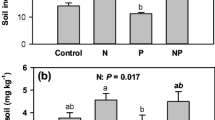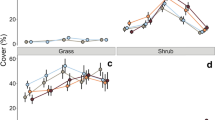Abstract
In arid ecosystems, the ability to rapidly capture nitrogen (N) from brief pulses is expected to influence plant growth, survival, and competitive ability. Theory and data suggest that N capture from pulses should depend on plant growth rate and availability of other limiting resources. Theory also predicts trade-offs in plant stress tolerance and ability to capture N from different size pulses. We injected K15NO3, to simulate small and large N pulses at three different times during the growing season into soil around the co-dominant Great Basin species Sarcobatus vermiculatus, Chrysothamnus nauseosus ssp. consimilis, and Distichlis spicata. Soils were amended with water and P in a partial factorial design. As predicted, all study species showed a comparable decline in N capture from large pulses through the season as growth rates slowed. Surprisingly, however, water and P availability differentially influenced the ability of these species to capture N from pulses. Distichlis N capture increased up to tenfold with water addition while Chrysothamnus N capture increased up to threefold with P addition. Sarcobatus N capture was not affected by water or P availability. Opposite to our prediction, Sarcobatus, the most stress tolerant species, captured less N from small pulses but more N from large pulses relative to the other species. These observations suggest that variation in N pulse timing and size can interact with variable soil water and P supply to determine how N is partitioned among co-existing Great Basin species.



Similar content being viewed by others
References
Aerts R, Chapin FS (2000) The mineral nutrition of wild plants revisited: a re-evaluation of processes and patterns. Adv Ecologic Res 30:1–67
Austin AT, Yahdjian L, Stark JM, Belnap J, Porporato A, Norton U, Ravetta D, Schaeffer SM (2004) Water pulses and biogeochemical cycles in arid and semiarid ecosystems. Oecologia 141:221–235
BassiriRad H, Caldwell MM (1992) Temporal changes in root growth and 15N uptake and water relations of two tussock grass species recovering from water-stress. Physiol Plantarum 86:525–531
BassiriRad H, Tremmel DC, Virginia RA, Reynolds JF, de Soyza AG, Brunell MH (1999) Short-term patterns in water and nitrogen acquisition by two desert shrubs following a simulated summer rain. Plant Ecol 145:27–36
Bilbrough CJ, Caldwell MM (1997) Exploitation of springtime ephemeral N pulses by six Great Basin plant species. Ecology 78:231–243
Bloom AJ, Chapin FS, Mooney HA (1985) Resource limitation in plants—an economic analogy. Ann Rev Ecol Syst 16:363–392
Cabrera ML, Beare MH (1993) Alkaline persulfate oxidation for determining total nitrogen in microbial biomass extracts. Soil Sci Soc Am J 57:1007–1012
Chesson P, Pacala S, Neuhauser C (2001) Environmental niches and ecosystem functioning. In: Kingzig A, Pacala S, Tilman D (eds) The functional consequences of biodiversity. Princeton University Press, Princeton, New Jersey, pp 213–245
Chesson P, Gebauer RLE, Schwinning S, Huntly N, Wiegand K, Ernest MSK, Sher A, Novoplansky A, Weltzin JF (2004) Resource pulses, species interactions, and diversity maintenance in arid and semi-arid environments. Oecologia 141:236–253
Collier MD, Fotelli MN, Nahm M, Kopriva S, Rennenberg H, Hanke DE, Gessler A (2003) Regulation of nitrogen uptake by Fagus sylvatica on a whole plant level—interactions between cytokinins and soluble N compounds. Plant Cell Environ 26:1549–1560
Comstock JP, Ehleringer JR (1992) Plant adaptation in the Great-Basin and Colorado Plateau. Great Basin Nat 52:195–215
Cui MY, Caldwell MM (1997a) A large ephemeral release of nitrogen upon wetting of dry soil and corresponding root responses in the field. Plant Soil 191:291–299
Cui M, Caldwell MM (1997b) Growth and nitrogen uptake by Agropyron desertorum and Pseudoroegneria spicata when exposed to nitrate pulses of different duration. Aust J Plant Physiol 24:637–642
Donovan LA, Richards JH (2000) Juvenile shrubs show differences in stress tolerance, but no competition or facilitation, along a stress gradient. J Ecol 88:1–16
Donovan LA, Richards JH, Muller MW (1996) Water relations and leaf chemistry of Chrysothamnus nauseosus ssp consimilis (Asteraceae) and Sarcobatus vermiculatus (Chenopodiaceae). Am J Bot 83:1637–1646
Donovan LA, Richards JH, Linton MJ (2003) Magnitude and mechanisms of disequilibrium between predawn plant and soil water potentials. Ecology 84:463–470
Drenovsky RE (2002) Effects of mineral nutrient deficiencies on plant performance in the desert shrubs Chrysothamnus nauseosus spp. consimilis and Sarcobatus vermiculatus. PhD Dissertation. University of California, Davis
Drenovsky RE, Richards JH (2004) Critical N:P values: predicting nutrient deficiencies in desert shrublands. Plant Soil 259:59–69
Drew MC, Saker LR (1975) Nutrient supply and the growth of seminal root systems in barely II localized compensatory increases in lateral root growth and rates of nitrate uptake when nitrate supply is restricted to only one part of the root system. J Exp Bot 26:79–90
Eissenstat DM, Caldwell MM (1988) Seasonal timing of root growth in favorable microsites. Ecology 69:870–873
Emery NC, Ewanchuk PJ, Bertness MD (2001) Competition and salt-marsh plant zonation: stress tolerators may be dominant competitors. Ecology 82:2471–2485
Fisher FM, Parker LW, Anderson JP, Whitford WG (1987) Nitrogen mineralization in a desert soil - interacting effects of soil moisture and nitrogen fertilizer. Soil Sci Soc Am J 51:1033–1041
Fitter AH (1986) Spatial and temporal patterns of root activity in a species rich alluvial grassland. Oecologia 69:594–599
Forde BG (2002) Local and long-range signaling pathways regulating plant responses to nitrate. Ann Rev Plant Biol 53:203–224
Forster JC (1995) Soil nitrogen. In: Alef K, Nannipieri P (eds) Methods in applied soil microbiology and biochemistry. Academic, San Diego, pp 79–87
Foyer CH, Valadier MH, Migge A, Becker TW (1998) Drought-induced effects on nitrate reductase activity and mRNA and on the coordination of nitrogen and carbon metabolism in maize leaves. Plant Physiol 117:283–292
Gebauer RLE, Ehleringer JR (2000) Water and nitrogen uptake patterns following moisture pulses in a cold desert community. Ecology 81:1415–1424
Gebauer RLE, Schwinning S, Ehleringer JR (2002) Interspecific competition and resource pulse utilization in a cold desert community. Ecology 83:2602–2616
Gleeson SK, Good RE (2003) Root allocation and multiple nutrient limitation in the New Jersey Pinelands. Ecol Lett 6:220–227
Gleeson SK, Tilman D (1992) Plant allocation and the multiple limitation hypothesis. Am Nat 139:1322–1343
Goldberg D, Novoplansky A (1997) On the relative importance of competition in unproductive environments. J Ecol 85:409–418
Grime JP (1977) Evidence for existence of three primary strategies in plants and its relevance to ecological and evolutionary theory. Am Nat 111:1169–1194
Grime JP (1994) The role of plasticity in exploiting environmental heterogeneity. In: Caldwell MM, Pearcy RW (eds) Exploitation of environmental heterogeneity by plants. Academic, San Diego, pp 2–19
Hodge A, Stewart J, Robinson D, Griffiths BS, Fitter AH (1999) Plant, soil fauna and microbial response to N-rich organic patches of contrasting temporal availability. Soil Biol Biochem 31:1517–1530
Hodge A, Robinson D, Fitter A (2000) Are microorganisms more effective than plants at competing for nitrogen? Trends Plant Sci 5:304–308
Ivans CY, Leffler AJ, Spaulding U, Stark JM, Ryel RJ, Caldwell MM (2003) Root responses and nitrogen acquisition by Artemisia tridentata and Agropyron desertorum following small summer rainfall events. Oecologia 134:317–324
Jackson RB, Caldwell MM (1989) The timing and degree of root proliferation in fertile-soil microsites for three cold-desert perennials. Oecologia 81:149–153
Jackson RB, Caldwell MM (1993) The scale of nutrient heterogeneity around individual plants and its quantification with geostatistics. Ecology 74:612–614
Jeuffroy MH, Ney B, Ourry A (2002) Integrated physiological and agronomic modeling of N capture and use within the plant. J Exp Bot 53:809–823
Kaye JP, Hart SC (1997) Competition for nitrogen between plants and soil microorganisms. Trends Ecol Evol 12:139–143
Kim TH, Jung WJ, Lee BR, Yoneyama T, Kim HY, Kim KY (2003) P effects on N uptake and remobilization during regrowth of Italian ryegrass (Lolium multiflorum). Environ Exp Bot 50:233–242
Larigauderie A, Richards JH (1994) Root proliferation characteristics of seven perennial arid land grasses in nutrient-enriched microsites. Oecologia 99:102–111
Mamolos AP, Veresoglou DS (2000) Patterns of root activity and responses of species to nutrients in vegetation of fertile alluvial soil. Plant Ecol 148:245–253
Matzner SL, Richards JH (1996) Sagebrush (Artemisia tridentata Nutt) roots maintain nutrient uptake capacity under water stress. J Exp Bot 47:1045–1056
McKane RB, Grigal DF, Russelle MP (1990) Spatiotemporal differences in 15N uptake and the organization of an old-field plant community. Ecology 71:1126–1132
Miranda KM, Espey MG, Wink DA (2001) A rapid, simple spectrophotometric method for simultaneous determination of nitrate and nitrite. Nitric oxide. Biol Biochem 5:62–71
Nadelhoffer KJ, Fry B (1994) Nitrogen isotope studies in forest ecosystems. In: Lajtha K, Michener R (eds) Stable isotopes in ecology. Blackwell, Oxford, pp 22–44
Neff JC, Chapin FS, Vitousek PM (2003) Breaks in the cycle: dissolved organic nitrogen in terrestrial ecosystems. Front Ecol Environ 1:205–211
Neter J, Wasserman W, Kutner MH (1990) Applied linear statistical models: regression, analysis of variance, and experimental design. 3 edn. Irwin, Homewood
Noy-Meir I (1973) Desert ecosystems: environments and producers. Ann Rev Ecol Syst 4:25–51
Nye P, Tinker P (1977) Solute movement in the soil-root system. University of California Press, Berkeley
Peek MS, Forseth IN (2003) Microhabitat dependent responses to resource pulses in the aridland perennial, Cryptantha flava. J Ecol 91:457–466
Sah RN, Miller RO (1992) Spontaneous reaction for acid dissolution of biological tissues in closed vessels. Anal Chem 64:230–233
SAS-Institute (2001) SAS/STAT user’s guide. Version 8. SAS Institute, Cary
Schjorring JK (1986) Nitrate and ammonium absorption by plants growing at a sufficient or insufficient level of phosphorus in nutrient solutions. Plant Soil 91:313–318
Seely B, Lajtha K (1997) Application of a 15N tracer to simulate and track the fate of atmospherically-deposited N of the costal forests of the Waquoit Bay Watershed, Cape Cod, MA. Oecologia 112:393–402
Smith SD, Monson RK, Anderson JE (1997) Physiological ecology of North American desert plants. Springer, Berlin, New York, Heidelberg
Snyder KA, Donovan LA, James JJ, Tiller RL, Richards JH (2004) Extensive summer water pulses do not necessarily lead to canopy growth of Great Basin and northern Mojave Desert shrubs. Oecologia 141:325–334
Stitt M (1999) Nitrate regulation of metabolism and growth. Curr Opin Plant Biol 2:178–186
Tilman D (1988) Plant strategies and the dynamics and structure of plant communities. Princeton University Press, Princeton
Vega-Jarquin C, Garcia-Mendoza M, Jablonowski N, Luna-Guido M, Dendooven L (2003) Rapid immobilization of applied nitrogen in saline-alkaline soils. Plant Soil 256:379–388
Yoder C, Caldwell M (2002) Effects of perennial neighbors and nitrogen pulses on growth and nitrogen uptake by Bromus tectorum. Plant Ecol 158:77–84
Acknowledgements
We thank S. Blazej, A. Breen, and R. O’Dell, for help with field and lab work, and R. Drenovsky, L. Jackson, and T. Young for manuscript review. This research was supported by the CA State Lands Commission (C99017), The Los Angeles Department of Water and Power, and NSF grants IBN-99-03004 and IBN-04-16581. Additional support was provided by the California Agricultural Experiment Station and a Jastro-Shields Research Fellowship. We are grateful to Alan Knapp and two anonymous reviewers for providing critical comments on an earlier version of the manuscript.
Author information
Authors and Affiliations
Corresponding author
Additional information
Communicated by Alan Knapp
Rights and permissions
About this article
Cite this article
James, J.J., Richards, J.H. Plant N capture from pulses: effects of pulse size, growth rate, and other soil resources. Oecologia 145, 113–122 (2005). https://doi.org/10.1007/s00442-005-0109-1
Received:
Accepted:
Published:
Issue Date:
DOI: https://doi.org/10.1007/s00442-005-0109-1




